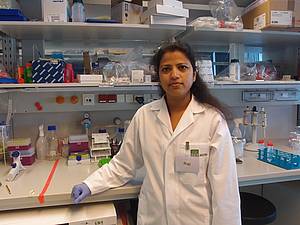July 28, 2017
The role of immune cells in childhood dementia
Postdoctoral fellow Rajeshwari Meli receives Hertha Firnberg Grant │Project to investigate the role of microglia in neuronal ceroid lipofuscinosis
Dementia is commonly thought of as a disease of advanced age. But around 50,000 children worldwide suffer from a form of childhood dementia, called neuronal ceroid lipofuscinosis (NCL). This group of inherited neurodegenerative disorders strikes children from early childhood. Loss of vision is an early sign of the disease, dementia and seizures are further symptoms. Although 14 disease-causing genes have been described, no cure for NCL exists and the disease invariably leads to the child’s death. Rajeshwari Meli, Postdoctoral fellow in the group of Sandra Siegert at the Institute of Science and Technology Austria (IST Austria) has received a Hertha Firnberg Grant to investigate what role microglia, a cell type involved in the brain’s immune defense, play in NCL.
So far, mouse models have been used to study the disease from the perspective of the neuron. However, activation of the immune system plays a role in NCL – a role which has not been the focus in these mouse models. In addition, mouse models can only partially reflect the disease phenotypes. In this project, Rajeshwari Meli will therefore tackle NCL from the immune perspective, looking at human microglia. Microglia are the resident immune cells of the nervous system, and have been implicated in the pathology of neurodegenerative diseases.
Previously, Prof. Siegert has shown that microglia in the retina are highly enriched for a set of NCL-causing genes. In their new project, they will study human microglia which carry these disease-causing genes and analyze their function. Using genome-editing techniques, the researchers will insert the most important disease-causing mutations into human induced pluripotent stem cells (iPS). Once they have differentiated these stem cells into microglia, they can compare mutation-carrying microglia with healthy microglia. In particular, they will study changes inside the microglia, as well as the cells’ interactions with the immune system. The study will give important insights into what role microglia play in NCL, with the potential of offering new strategies for cell-based therapeutic drug approaches.
Rajeshwari Meli joined Sandra Siegert’s group at IST Austria as postdoctoral fellow in 2016. Meli received her M.Sc in Applied Genetics from Karnatak University, India, in 2006. She then worked as Research Fellow at the National Institute of Immunology in New Delhi, the Institute of Genomics and Integrative Biology in Delhi and at the National Center for Biological Sciences in Bengaluru, India. In 2009, Meli joined the Vienna Biocenter for her doctoral studies. She received her PhD in 2014 for her investigation of axonal guidance.
The Hertha Firnberg Programme for postdocs by the Austrian Science Fund FWF aims to support women at the start of their scientific careers. The programme was established in 1998, and is geared towards highly-qualified graduates of any scientific discipline. Successful applicants are funded for up to three years. The programme is named in honour of Hertha Firnberg, Austria’s first federal minister of science.




